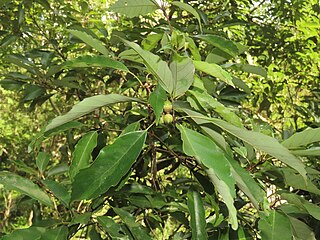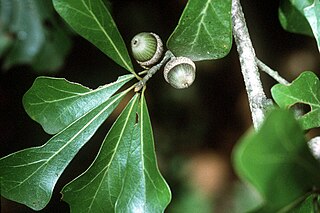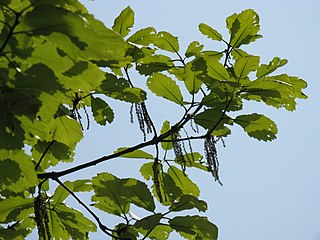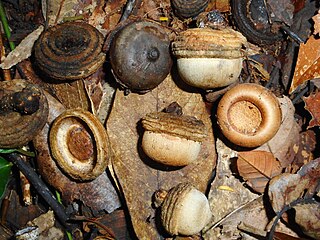
An oak is a hardwood tree or shrub in the genus Quercus of the beech family. They have spirally arranged leaves, often with lobed edges, and a nut called an acorn, borne within a cup. The genus is widely distributed in the Northern Hemisphere; it includes some 500 species, both deciduous and evergreen. Fossil oaks date back to the Middle Eocene. Molecular phylogeny shows that the genus is divided into Old World and New World clades, but many oak species hybridise freely, making the genus's history difficult to resolve.

Quercus laurifolia is a medium-sized semi-evergreen oak in the red oak section Quercus sect. Lobatae. It is native to the southeastern and south-central the United States.

Quercus glauca, commonly called ring-cupped oak or Japanese blue oak, is a tree in the beech family (Fagaceae). It is native to eastern and southern Asia, where it is found in Afghanistan, Bhutan, China, northern and eastern India, southern Japan, Kashmir, Korea, Myanmar, Nepal, and Vietnam. It is placed in subgenus Cerris, section Cyclobalanopsis.

Quercus acutissima, the sawtooth oak, is an Asian species of oak native to China, Tibet, Korea, Japan, Indochina and the Himalayas. It is widely planted in many lands and has become naturalized in parts of North America.

Quercus dentata, also called Japanese emperor oak or daimyo oak is a species of oak native to East Asia. The name of the tree is often translated as "sweet oak" in English to distinguish it from Western varieties. It is placed in section Quercus.

Quercus variabilis, the Chinese cork oak, is a species of oak in the section Quercus sect. Cerris, native to a wide area of eastern Asia in southern, central, and eastern China, Taiwan, Japan, and Korea.

Quercus nigra, the water oak, is an oak in the red oak group, native to the eastern and south-central United States, found in all the coastal states from New Jersey to Texas, and inland as far as Oklahoma, Kentucky, and southern Missouri. It occurs in lowlands and up to 450 meters in elevation.

Quercus cornelius-mulleri is a North American species of oak known by the common name Muller oak, or Muller's oak. It was described to science in 1981 when it was segregated from the Quercus dumosa complex and found to warrant species status of its own. It was named after ecologist Cornelius Herman Muller. It is native to southern California and Baja California, where it grows in chaparral, oak woodlands, and other habitat in foothills and mountains. It can most easily be observed in Joshua Tree National Park and in the woodlands along the western margins of the Colorado Desert in San Diego County, California.

Quercus aliena, the galcham oak or oriental white oak, is a species of oak in the family Fagaceae, in the white oak section Quercus.

Quercus acuta, the Japanese evergreen oak, is an oak native to Japan, South Korea, Taiwan, and China's Guizhou Province and Guangdong Province. It is placed in subgenus Cerris, section Cyclobalanopsis.

Quercus franchetii, commonly known as the zhui lian li evergreen oak, is a species of oak in the Ilex section of the genus, native to a wide area of eastern Asia. It is an oak native to China, northern Thailand and Vietnam, growing at altitudes between 800 and 2,600 metres.

Quercus similis, the swamp post oak or bottomland post oak, is an oak species native to the southeastern and south-central United States. The greatest concentration of populations is in Louisiana and Arkansas, Mississippi, and eastern Texas, with isolated population in Missouri, Alabama, and the Coastal Plain of Georgia and South Carolina.
Quercus augustinii is a rare species of tree in the beech family Fagaceae. It has been found in Vietnam as well as Guangxi, Guizhou, and Yunnan Provinces in southern China. It is placed in subgenus Cerris, section Cyclobalanopsis.
Quercus austrocochinchinensis is an uncommon species of tree in the beech family Fagaceae. It has been found in Vietnam and Thailand as well as Yunnan Province in southern China. It is placed in subgenus Cerris, section Cyclobalanopsis.

Quercus kerrii is an uncommon Asian species of tree in the family Fagaceae. It is native to Thailand and Vietnam. There are also populations in southern China that according to some authors belong to Q. kerrii but considered by others to belong to a different species, Q. helferiana.Quercus kerrii is placed in subgenus Cerris, section Cyclobalanopsis. Its Chinese name is mao ye qing gang.

Quercus rex is an Asian species of tree in the family Fagaceae. It has been found in the seasonal tropical forests of northern Indochina, northeastern India, and also in the province of Yunnan in southwestern China. It is placed in subgenus Cerris, section Cyclobalanopsis.
Quercus langbianensis is an uncommon oak tree species in the family Fagaceae. It is placed in subgenus Cerris, section Cyclobalanopsis, the ring-cupped oaks. These differ from other Quercus groups in that they have acorns with distinctive cups: usually with substantial rings, made-up of scales that have grown together. This species can be found in sub-tropical and tropical seasonal forests of Vietnam.

Quercus subgenus Cerris is one of the two subgenera into which the genus Quercus was divided in a 2017 classification. It contains about 140 species divided among three sections. It may be called the Old World clade or the mid-latitude clade; all species are native to Eurasia and North Africa.
Quercus blaoensis is the accepted name of a critically endangered oak tree species. It is estimated that there are fewer than 50 mature individuals. This species belongs the Asian sub-genus of Quercus within the family Fagaceae. It differs from other Quercus subgenera in that they have acorns with distinctive cups, characterised by growing rings of scaly protrusions and densely grouped acorns. This species is endemic to southeastern Vietnam where it inhabits evergreen seasonal tropical forests at altitudes of 200–1100 metres. It is named after 'Blao', the name used by the Chau Ma minority people for Bảo Lộc.























